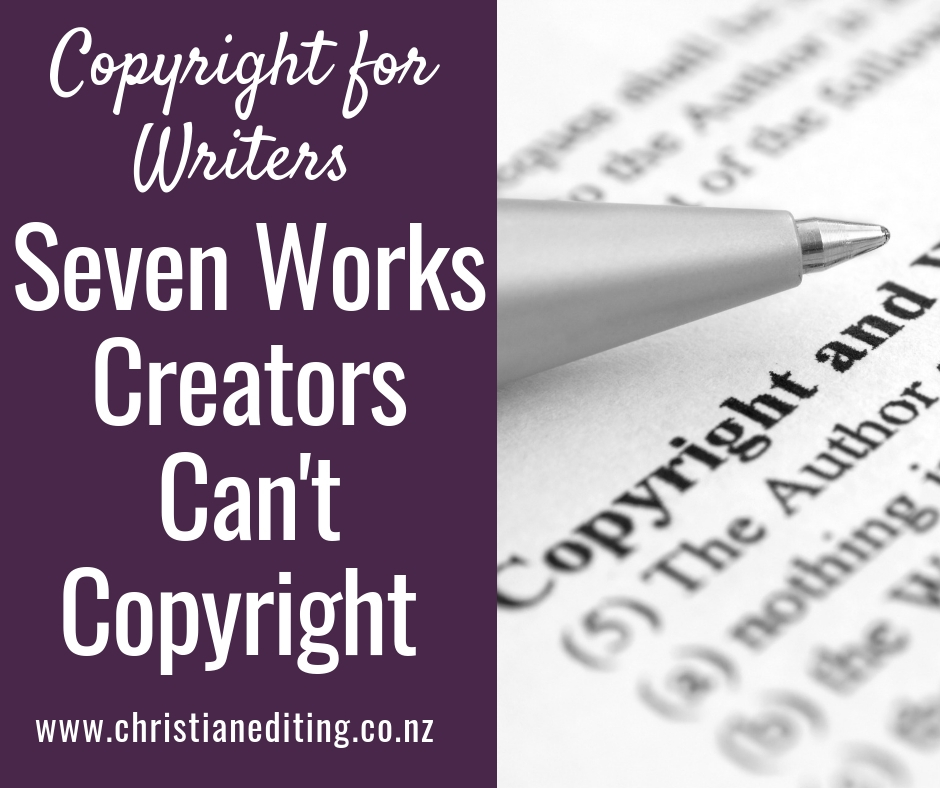Over the last four weeks, I’ve covered various aspects of copyright and copyright law:
- Understanding Copyright
- Using Copyrighted Material
- Understanding Fair Use and Fair Dealing
- Using Images in Blog Posts
This week I’m discussing seven works creators can’t copyright—and why not.
Note: I’m not a lawyer and this is not legal advice. You get legal advice by consulting a lawyer qualified in the specific legal area, and licensed to practice in your location. There are common principles in international copyright law, but the application of those principles does vary by jurisdiction.
Copyright law is a branch of intellectual property (IP) law, which applies internationally. The World Intellectual Property Organisation (part of the United Nations) defines intellectual property as “creations of the mind”, and divides IP into five types:
- Copyright
- Patents
- Trademarks
- Industrial designs
- Geographic indicators
Copyright is covered internationally under the 1886 Berne Convention for the Protection of Literary and Artistic Works, while patents, trademarks, and industrial designs are covered under the 1883 Paris Convention for the Protection of Intellectual Property.
These four types of works are protected under other forms of intellectual property law, and therefore can’t be copyrighted:
Patents
Patents protect inventions and machines, from the invention of the light bulb (one of Thomas Edison’s many patents) to nanotechnology. A patent is a generally a new way of doing something, or a new technical solution to a problem. Patent applications are dealt with by specialist patent attorneys.
Patents must offer workable solutions. The idea of a perpetual motion machine has been around for centuries, but no one has yet invented and patented such a machine. Equally, the warp drive or faster-than-light engine is a staple of science fiction, but has yet to be invented.
Trademarks
Trademarks inform consumers the product or service comes from a particular company. For example, Nike manufactures footwear and clothing with the “swoosh” design. Coca-Cola manufactures drinks with the “dynamic ribbon device”.
Trademark law also includes service marks, which identifies and protects the provider of a service.
Industrial Designs
Industrial designs can also be protected by intellectual property law, including shape, colour, patterns, lines, features, or the ornamental or aesthetic aspect. Note that not all designs are protected. Many fashion designs are not protected, as they are not deemed sufficiently original. (This explains how chain stores can get away with selling cheap mass-produced copies of designer clothes).
Geographic Indicators
Geographic indicators inform consumers the product comes from a particular place, and the “qualities, characteristics or reputation of the product should be essentially due to the place of origin“. For example, champagne must come from the Champagne region of France. Otherwise it’s sparkling wine.
What Else Can’t be Copyrighted?
Section 102 of the U.S. Copyright Act states:
Copyright protection subsists, in accordance with this title, in original works of authorship fixed in any tangible medium of expression … In no case does copyright protection for an original work of authorship extend to any idea, procedure, process, system, method of operation, concept, principle, or discovery.
To be able to be protected by copyright, something must be:
- Original
- Tangible (i.e. written or recorded in a form that can be copied)
Copyright is therefore limited to the tangible expression of original works. This excludes ideas, titles and names, and recipes (among other things).
Ideas
Ideas can’t be copyrighted because they are not tangible. And they may not be original—how can we know if they are not written down?
As the US Copyright Office says:
You may express your ideas in writing or drawings and claim copyright in your description, but be aware that copyright will not protect the idea itself as revealed in your written or artistic work.
Titles and Names
Titles and names (e.g. character names or pen names) aren’t subject to copyright. They are considered too short to be original.
However, you may be able to trademark a series title or a character name if you can show an original and unique use. For example, you might be able to trademark a unique word or phrase in a custom font, but you can’t trademark a word in common usage in your genre and expect to be able to enforce it.
Recipes
Have you ever visited Pinterest looking for a recipe? You find what looks like a good recipe and click through to the website, where you have to wade through what seems like the blogger’s entire life story before you get to the good stuff: the list of ingredients and the instructions.
Bloggers do this because the list of ingredients isn’t subject to copyright. Even the instructions are only subject to copyright if there is something creative about them (e.g. saying “cream the butter and the sugar” isn’t deemed creative, but posting a photograph or a video of creaming the butter and the sugar is).
What is subject to copyright is the blogger’s life story, and the accompanying photographs, which is why a Pinterest recipe is so much more than a recipe.
Conclusion
Copyright protects the author’s expression, but not the underlying facts, ideas, or theories, no matter now novel those may be … what counts is not quality or novelty but only that the work be original.
(Chicago Manual of Style, 17th edition, 4.5)
These aren’t the only seven works creators can’t copyright, but I think they are the most common. If you want to find out more, then click here to read Works Not Covered by Copyright from the US Copyright Office.


